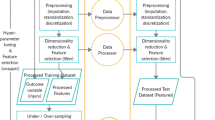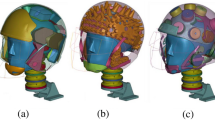Abstract
Aircraft ejection systems are lifesaving devices used, in case of emergencies for military pilots. As per current literature the success rate of ejections happening in low altitudes (below 150 m) is 51.2%. The success rate of an ejection depends on various parameters such as height for parachute full deployment, ejection posture, spinal alignment, restraints etc. This paper proposes a multi objective optimization based on a novel injury parameter and the dynamic conditions of the aircraft prevailing during the time of emergency to choose the optimal impulse required for safe ejection. This injury parameter is capable of modelling the spine in different postures. A non-linear seat restraint interaction is also modelled to include the effect of varying slackness of seat restraints there by optimizing force applied for the different physical conditions of the pilot, which hasn’t been reported in literature yet. The Pareto solutions obtained thereof indicates the dangers associated with posture during the ejection process. The optimal solutions after decision making are used to train a two stage Artificial Neural Network architecture to choose optimal parameters for different ejection scenarios. The ANN proposed was seen to give good results which were along the generated Pareto fronts for different simulated aircraft conditions instantaneously.


















Similar content being viewed by others
References
Bishop CM (2006) Pattern recognition and machine learning. Springer, Berlin
Brinkley JW, Shaffer JT (1971) Dynamic simulation techniques for the design of escape systems: current applications and future air force requirements. Tech. rep, Air Force Aerospace Medical Research Lab Wright-Patterson AFB OH
Cheng Z, Rizer AL, Pellettiere JA (2003) Computational analyses of ejection seat cushions for optimal control of spinal injuries. Tech. rep, SAE Technical Paper
Deb K, Pratap A, Agarwal S, Meyarivan T (2002) A fast and elitist multiobjective genetic algorithm: NSGA-II. IEEE Trans Evol Comput 6(2):182
Du C, Mo Z, Tian S, Wang L, Fan J, Liu S, Fan Y (2014) Biomechanical investigation of thoracolumbar spine in different postures during ejection using a combined finite element and multi-body approach. Int J Numer Methods Biomed Eng 30(11):1121
Griffith M (1990) Human vibration handbook
Kalavsky P, Socha V, Socha L, Kutilek P, Gazda J, Kimlickova M (2015) In: 2015 International conference on military technologies (ICMT). IEEE, pp 1–5
Kitazaki S, Griffin MJ (1997) A modal analysis of whole-body vertical vibration, using a finite element model of the human body. J Sound Vib 200(1):83
Lewis M (2002) Spinal injuries caused by the acceleration of ejection. J R Army Med Corps 148(1):22
Lou J, Sun J, Tang S, Li H (2014) Study on the optimization of the shock isolation system based on the limiting performance analysis. Int J Dyn Control 2(3):415
Liu Y, Pontius UR, Hosey RR (1973) The effects of initial spinal configuration on pilot ejection. Tech. rep, Army Aeromedical Research Lab Fort Rucker Al
Mao XD, Lin GP, Yu J (2011) Predicting ejection velocity of ejection seat via back propagation neural network. J Aircr 48(2):668
MATLAB (2018) Version 7.10.0 (R2018a). The MathWorks Inc., Natick, Massachusetts
Naveen Raj R, Shankar K (2020) An improved spinal injury parameter model for under body impulsive loading scenarios title. Int J Numer Methods Biomed Eng e3307
Newman DG (2013) Survival outcomes in low-level ejections from high performance aircraft. Aviat Space Environ Med 84(10):1061
Raj RN, Shankar K (2020) Human Factors and Mechanical Engineering for Defense and Safety 4(1):6
Robinson G, Jovanoski Z (2010) Fighter pilot ejection study as an educational tool. Teach Math Appl Int J IMA 29(4):176
Saad EW, Wunsch DC II (2007) Neural network explanation using inversion. Neural Netw 20(1):78
Shanahan DF (2004) Human tolerance and crash survivability. Pathological aspects and associate biodynamics in aircraft accident investigation
Singh B (2007) Indian Journal of Aerospace Medicine: Special Commemorative Volume May, p 64
Stech EL, Payne PR (1969) Dynamic models of the human body. Tech. rep, Frost Engineering Development Corp Englewood Co
Stemper B, Yoganandan N, Paskoff G, Fijalkowski R, Storvik S, Baisden J, Pintar F, Shender B (2011) Thoracolumbar spine trauma in military environments. Minerva Ortopedica E Traumatologica 62(5):397
Thyagarajan R, Ramalingam, J, Kulkarni KB (2014) Comparing the use of dynamic response index (DRI) and lumbar load as relevant spinal injury metrics. Tech. rep., Comparing the use of dynamic response index (DRI) and lumbar load as relevant spinal injury metrics
USAF (2007) Mil-dtl-9479 rev. e. Tech. rep
USAF (2016) Mil-hdbk-516cn-56. Tech. rep
U.S.O. of the Chief of Naval Operations (2001) NATOPS Flight Manual: Navy Model F/A-18E/F 165533 and Up Aircraft. Naval Air Technical Data and Engineering Services Command, Naval Air Station, North Island. https://books.google.co.in/books?id=Ol2jYgEACAAJ
U.S.O. of the Chief of Naval Operations, U.S.N.A.S. Command (2008) NATOPS Flight Manual: Navy Model AV-8B Aircraft 161573 and Up. The Command. https://books.google.co.in/books?id=7WguHQAACAAJ
Wenchun F, Guiping L (2007) Multi-parameter and multi-mode control simulation analyses of ejection seat. J Syst Simul 19(10):2283
White A, Panjabi M (1978) Clinical biomechanics of the spine. Lippincott. https://books.google.co.in/books?id=U5NsAAAAMAAJ
Wise KA, Brinker JS (1996) Linear quadratic flight control for ejection seats. J Guid Control Dyn 19(1):15
Wolf E (2007) Development of seat shock isolation systems. Ph.D thesis, University of Nevada, Las Vegas
Zhang M, Wu M, Su Y, Zhang C (2016) Researching attitude-control algorithm of ejection seats based on time-sharing strategy. In: ICINCO (2) (2016), pp 262–267
Author information
Authors and Affiliations
Corresponding author
Additional information
Publisher's Note
Springer Nature remains neutral with regard to jurisdictional claims in published maps and institutional affiliations.
Rights and permissions
About this article
Cite this article
Naveen Raj, R., Shankar, K. A two stage neural network for choosing optimal ejection parameters in low altitude seat ejection based on novel injury parameter. Optim Eng 23, 827–853 (2022). https://doi.org/10.1007/s11081-021-09607-1
Received:
Revised:
Accepted:
Published:
Issue Date:
DOI: https://doi.org/10.1007/s11081-021-09607-1




